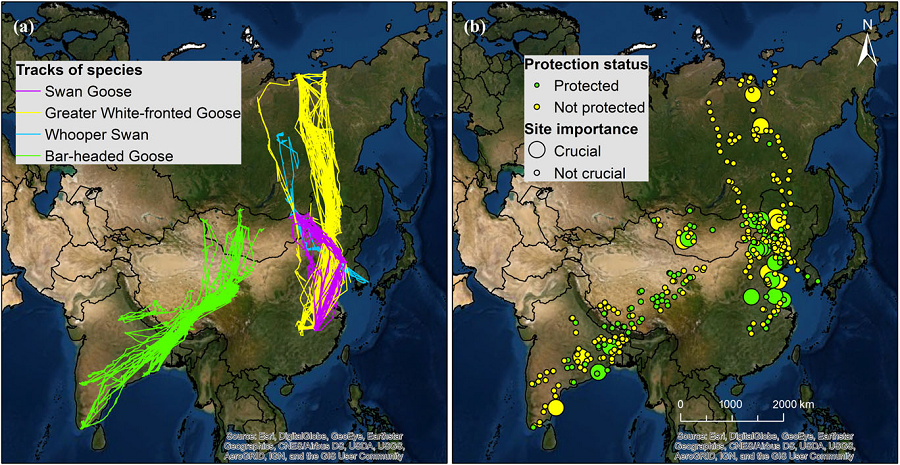In August 2019, the research group led by Prof. Gong Peng and Prof. Si Yali in the Department of Earth System Science published a research paper entitled "A network approach to prioritize conservation efforts for migratory birds" on the online journal Conservation Biology. The paper proposed a new approach to prioritize protection strategy for migratory bird habitat based on network analysis.
Habitat loss can trigger migration network collapse by isolating migratory bird breeding grounds from nonbreeding grounds. Theoretically, the same degree of habitat loss from sites at different network locations could have completely different impacts on migratory birds, ranging from not affecting the population size at all to causing rapid extirpation of the species. However, migration‐network connectivity and the impacts of site loss are not completely understood. And conservation strategy is based on the intrinsic characteristic of the habitat alone.
In this study, the researchers investigated how migration‐network connectivity was affected by site‐specific habitat loss and node‐specific network metrics. Using high‐resolution GPS tracking data, they quantified migration‐network connectivity for large‐bodied waterfowl species in the Central and East Asian–Australasian Flyways. They quantified the importance of each stopover site based on its contribution to the network's resistance relative to bird migration. These data, together with the degree of habitat loss and the protection status of these sites, were used to identify sites for which conservation efforts should be prioritized. They sought to inform priority setting for site conservation.
 Figure 1. (a) Satellite tracks and (b) breeding, nonbreeding, and stopover sites of swan geese, greater white‐fronted geese, whooper swans, and bar‐headed geese
Figure 1. (a) Satellite tracks and (b) breeding, nonbreeding, and stopover sites of swan geese, greater white‐fronted geese, whooper swans, and bar‐headed geese
In general, migration networks with fewer stopover sites were more vulnerable to habitat loss. Node removal in order from the highest to lowest degree of habitat loss yielded an increase of network resistance similar to random removal. In contrast, resistance increased more rapidly when removing nodes in order from the highest to lowest betweenness value (quantified by the number of shortest paths passing through the specific node). They quantified the risk of migration network collapse and identified crucial sites by first selecting sites with large contributions to network connectivity and then identifying which of those sites were likely to be removed from the network (i.e., sites with habitat loss). Among these crucial sites, 42% were not designated as protected areas. Setting priorities for site protection should account for a site's position in the migration network, rather than only site‐specific characteristics. Their framework for assessing migration‐network connectivity enables site prioritization for conservation of migratory species.
The first author of this paper is Xu Yanjie, a student in the joint Ph.D. program of Tsinghua University and Wageningen University. The corresponding author is Associate Professor Si Yali from the Department of Earth System Science of Tsinghua University. The collaborators include Prof. Gong Peng from the Department of Earth System Science, Associate Professor de Boer, Professor Prins and Dr. Yin Shenglai from Wageningen University, Liu Qiang from Delft University of Technology, and Scientist Takekawa and Prosser of the US Geological Survey.
Fulltext link:
Xu, Y., Si, Y., Takekawa, J., Liu, Q., Prins, HHT, Yin, S., Prosser, DJ, Gong, P. and de Boer, WF (In Press). A network approach To prioritize conservation efforts for migratory birds. Conservation Biology. doi:10.1111/cobi.13383
Https://conbio.onlinelibrary.wiley.com/doi/full/10.1111/cobi.13383?af=R